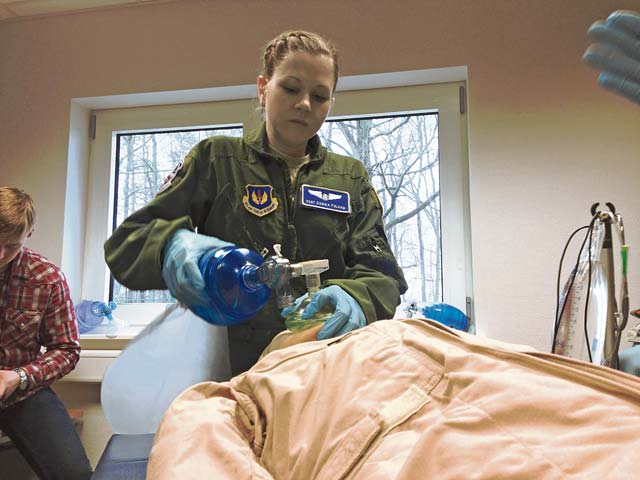
Field ready. Air power. Agile warfare. Combat lifesaver.
All of these terms have one common denominator; without the proper training and education, they mean nothing. Years of research and development have gone into creating the elite group that is the U.S. Air Force, and even during times of reduced funding, they must keep a sharpened edge.
“What it boils down to is providing clinical and organizational-wide competency,” said Lt. Col. Kim Robinson, 86th Medical Group training and education officer. “We want to ensure everyone is trained and competent to complete the duties they volunteered for.”
This means keeping all units sharpened while sheathed. But, the Air Force still has missions that are consistently on display.
One of the missions that is a constantly visible is aeromedical evacuation, taking wounded warriors from the battlefield in Southwest Asia, to Ramstein and then to their final destination in the U.S.
“We offer many different training opportunities for our medical brothers and sisters in the (KMC), including the aeromedical evacuation flights,” said Staff Sgt. Benny Algarin, 86th MDG director of basic life support and automatic external defibrillator training. “We provide support for training and can step in to instruct when shortages arise.”
Aside from giving the training, the training and education flight allows the use of their training facilities that have “smart dummies,” which can replicate an array of medical emergencies from amputees to heart attacks.
“The hands-on training provided should be as realistic as possible,” said Master Sgt. Jose Loureiro, 86th MDG emergency medical technician coordinator. “The realism allows for our medical technicians and nurses to see how a body should react in a given scenario.”
Another big part of the medical training and education is ensuring medical professionals complete their annual readiness skills verification training. The RSV training ensures nurses and medical technicians are proficient in the basic to specialty-specific skills needed. The training is required every 20 to 40 months and is determined by the medical group’s readiness flight, based on who is scheduled to deploy or when they are overdue for training.
“RSV are skills necessary for medics to be trained and competent in performing when in a deployed environment,” Robinson said. “Without it, the medic would be without the necessary skills to provide life-saving aid to those who may need it most.”
“These are all proven war time life-saving skills,” Algarin said. “Without them, we wouldn’t be able to provide the kind of aid necessary to bring our Airmen home.”
These skills and education, coupled with self-aid and buddy care training, can mean the difference between life and death, not only on the battlefield, but at home as well in the event of a crisis situation. It’s up to the men and women in the tiger-striped Airmen battle uniform to help guarantee your life is in good hands.


